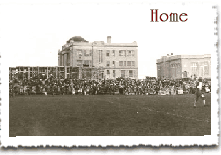Village
History
The area that became Shorewood in 1917 was first sighted 343
years earlier by the French explorer Pere Jacques Marquette and his
party as they canoed past this virgin territory on Lake Michigan.
The area was then the hunting grounds of the Sioux and Algonquin
Indians.
Explorer and trappers soon found their way to this territory. The
area remained Indian property until 1832 when the United States
government purchased the land east of the Milwaukee River from the
Menominees. The natural resources of water power and valuable timber
attracted settlers who struggled to establish industries and
communities for the next 85 years. For example:
 |
Mechanicsville, in
1836, built around the site of a dam and two sawmills on the
east bank of the Milwaukee River, just south of the present
Capitol Drive bridge. |
 |
Humboldt,
in 1850, included a paper mill and flour mill |
 |
Cementville,
in 1876, built a mill to grind the natural limestone, added
additional plants and a post office. This industry survived
for the next 20 years. |
In 1872, a resort proprietor opened Lueddemann's-on-the River on
the current site of Hubbard Park which attracted visitors by boat
from the city. Just a year later, the steam engines and cars of the
Northwestern Union Railway laid the first tracks across the
Shorewood plateau and, by 1886, the Whitefish Bay Railway Company
extended the route to that neighboring north suburb.
Lueddemann's resort profited from this new mode of transportation
and was the beginning of a succession of amusement parks that
stretched east from the river to what is now Oakland Ave.
(Zwietusch's Mineral Springs, Coney Island in 1900, Wonderland in
1905, and Ravenna in 1909.) The era of resort/amusement parks ended
in 1916. However, it was the Coney Island Park that prompted the
break from the Town of Milwaukee to what was renamed East Milwaukee.
City dwellers who had begun to settle in the area were
dissatisfied with Milwaukee's lack of attention to road improvement,
and they were reluctant to pay taxes to the town on the thriving
amusement parks, to say nothing of the raucous visitors who were far
more disturbing than previous enterprises.
In August, 1900, (with a population of 300), 68 voters went to
the polls, and, with 45 votes needed, established the new entity
that was named East Milwaukee. The small village grew to 1,255 by
1913; cement sidewalks were added (1910); street signs and gas mains
(1911) and the first paved street (1913) was Richland Court.
In 1917, the name was changed to Shorewood to more accurately
reflect the environment that attracted business and professional
people who built substantial homes outside the city but convenient
to city resources.
The population reached 13,479 by 1930, with a peak population of
16,199 in 1950.
Today, with a stable population of 14,000, the one-mile square
Village of Shorewood is the most densely populated community in the
State of Wisconsin.
AS WE WERE
The current
Shorewood Village Hall was originally built as a four-room
schoolhouse in 1908 by the Town of Milwaukee. In 1916 the Village of
East Milwaukee purchased the building to house its offices. Named to
the National Register of Historic Places in 1984, the building has
undergone a series of renovations.
The current Shorewood business district (the area of Oakland Ave.
and Capitol Drive) was originally the home of the Light Horse
Squadron. Between 1910 and 1929, the 105th Cavalry Unit of the
Wisconsin National Guard had its armory and drill fields between the
present Sendik's and Walgreen's. The squadron, on horseback, trained
and paraded on the ground. The site is marked with a State
Historical Society plaque on the southwest corner of Oakland and
Kenmore.
Originally, the Village Board was composed of six trustees and a
Village president who assumed the full responsibility and management
of the community. However, with the growth of the Village in the
1920's and increasing demands on the trustees' time, the Board hired
a Village Manager in 1928. The trustee/manager form of government
has been in place since then.
Original library services in Shorewood date to 1903 when East
Milwaukee funded a librarian and appointed a library board. From the
early 1900's until 1965, the library occupied various locations,
including the basement of the Village Hall and five different
storefront locations. With its permanent location, completed in
1965, the village had its first full service library. In 2003
the current library was completely renovated and expanded to include
the Historical Society, Health Department, and Senior Center.
The Shorewood Police Department was organized in 1920 and, since
1929, has been headquartered in its present building, earlier called
the Safety Building.
The Shorewood Fire Department was organized in 1929.
Headquartered with the police department, the North Shore's only
remaining original brass fire pole was retained when the building
was expanded in 1965.
The first Health officer in the Village was appointed in 1901 and
a Health Department was organized in 1918. A school nurse was hired
and a program for child health care was developed. In the 1930's,
the department received national recognition for its measles-
surveillance program.
REFERENCES AND
SUGGESTED FURTHER READING:
"Profile of Shorewood"
published in 1978
"Images of America
-Shorewood, Wisconsin published in
2000





